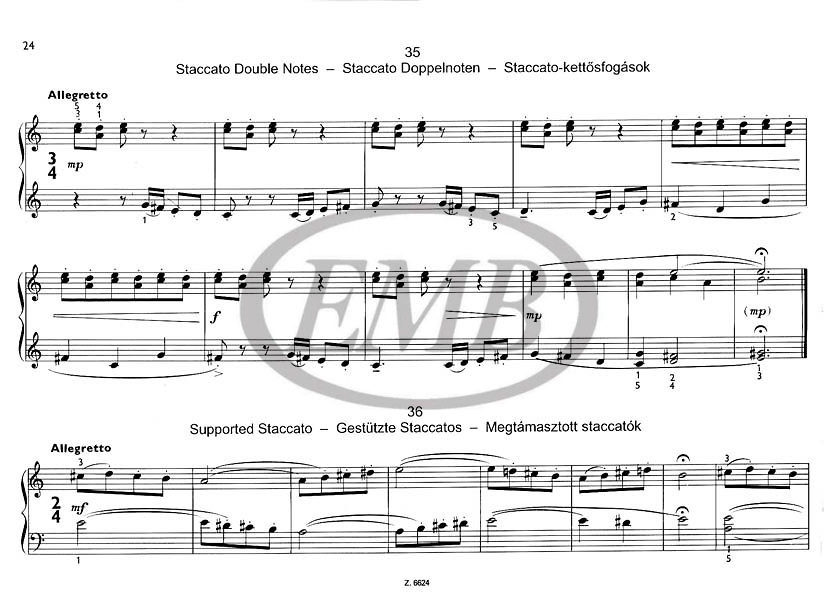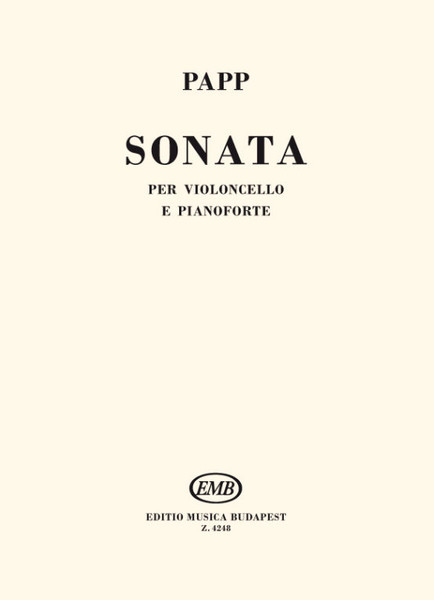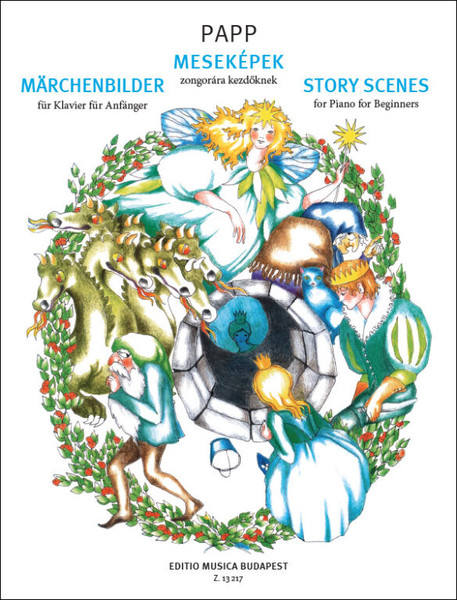Description
Papp Lajos: Starting the Piano / Első játékok a zongorán – Introduction to Tone and Movement in Modern Music
Product Details
- UPC: Not specified
- Product Type: Sheet Music / Instrumental Method
- Brand Name: Editio Musica Budapest Zeneműkiadó
- MPN (Manufacturer Part Number): 6624
- Genre: Pedagogical performance pieces
- Style: Modern Music, Technical Studies, Contemporary Pedagogy
- Author: Papp Lajos
- Setting: Piano
- Language: Hungarian, English
- ISMN: 979-0080066249
Overview: Preparing for the Sound World of Modern Piano Music
Starting the Piano (Első játékok a zongorán) by Papp Lajos is an innovative collection of forty small, study-like piano pieces intended for use at the very beginning of piano instruction (Grade 1-2). Unlike traditional tutors focused purely on classical techniques like scales and broken chords, this volume prepares the student for the demands and expressive possibilities of modern music.
Papp Lajos argues that contemporary piano works require a richness of color, a secure sense of position, rhythmic imagination, and adaptability that goes beyond older technical formulas. These pieces offer assistance to a pedagogy that emphasizes increased training in movement forms and the development of a discerning ear capable of controlling the sounding variety required by 20th and 21st-century composers.
The pieces explore concepts like double notes, tremolo, changing meters, alternating intervals, and dynamic shifts (subito changes), pushing the student toward developing a refined touch and a capacity for lightning adaptation. While focused on modern music, the collection naturally presupposes the concurrent study of traditional piano technique. This publication is officially recognized and listed in the curriculum program for basic-level arts education in Hungary.
HU: Összefoglalás: Felkészülés a Kortárs Zongorajáték Hangzásvilágára
Papp Lajos Első játékok a zongorán című kiadványa negyven apró, etűdszerű zongoradarabot tartalmazó innovatív gyűjtemény, amelyet a zongoratanulás legkorábbi szakaszára (1-2. fokozat) szántak. Ezt a kötetet nem a klasszikus skálákra és felbontott akkordokra fókuszáló hagyományos iskolákhoz hasonlóan írták; célja, hogy felkészítse a tanulót a kortárs zene igényeire és kifejező lehetőségeire.
Papp Lajos szerint a kortárs zongoraművek olyan színgazdagságot, biztos helyérzéket, ritmikai fantáziát és alkalmazkodóképességet igényelnek, amelyek túlmutatnak a régebbi technikai formulákon. Ezek a darabok ahhoz a pedagógiához nyújtanak segítséget, amely a megszólaltatás mozgásformáinak fokozott kiművelését és egy olyan hallás kifejlesztését hangsúlyozza, amely képes ellenőrizni a 20. és 21. századi zeneszerzők által megkövetelt megszólaló sokféleséget.
A darabok olyan zenei koncepciókat dolgoznak fel, mint a kettősfogások, tremolo, metrumváltás, váltakozó hangközök és dinamikai váltások (subito), finom billentésre és villámgyors alkalmazkodásra késztetve a diákot. Bár a kortárs zenére összpontosít, a gyűjtemény természetesen feltételezi a hagyományos zongoratechnika párhuzamos tanulását. Ez a kiadvány szerepel az alapfokú művészetoktatás tantervi programjában.
Product Features
- Format: Paperback, Landscape Bach format ($30,2 \text{ x } 23 \text{ cm}$)
- Length: 28 pages
- Weight: $0.113 \text{ kg}$
- Grade Level: 1-2 (Nehézségi fok: 1-2)
- Number of Pieces: 40 small études.
- Focus: Introduction to modern music sound and movement forms.
- Bilingual Instruction: Text and titles are provided in Hungarian and English.
- Target Skills: Developing positional security, rhythmic imagination, control over color and dynamics (nuances of touch).
Interesting Facts: A Bridge to the 20th Century
Published in 1973, Starting the Piano was a forward-thinking pedagogical work for its time, recognizing that standard 19th-century technical exercises were insufficient for the demands of contemporary composers. Papp Lajos, a major figure in Hungarian music education, aimed to bridge the gap between traditional teaching and the language of modern music, often drawing from the spirit of composers like Bartók who innovatively integrated folk and modern elements.
The pieces, which function as technical studies (etűdök), focus on specific problems in modern execution, such as non-scalar movements (Leap Exercise in Pairs of Notes), modal melodies (Lydian, Phrygian), and sudden dynamic contrasts ('Subito' Dynamic Changes). This makes the tutor highly relevant for students whose musical journey includes exploring music written since the mid-20th century. The inclusion in the official Hungarian arts education curriculum confirms its lasting educational value.
HU: Érdekes Tények: Híd a 20. Századhoz
Az Első játékok a zongorán, melyet 1973-ban adtak ki, a maga idejében előremutató pedagógiai műnek számított, felismerve, hogy a hagyományos 19. századi technikai gyakorlatok már nem elegendőek a kortárs zeneszerzők igényeinek kielégítésére. Papp Lajos, a magyar zeneoktatás egyik kiemelkedő alakja, célul tűzte ki a hagyományos tanítás és a modern zene nyelve közötti szakadék áthidalását, gyakran Bartók szelleméből merítve, aki újszerűen integrálta a népi és a modern elemeket.
A darabok, amelyek technikai etűdként funkcionálnak, a modern előadás speciális problémáira összpontosítanak, mint például a nem skálaszerű mozgások (Ugrásgyakorlat hangpárokban), a modális dallamok (Lídes, Fríg dallam), és a hirtelen dinamikai kontrasztok ('Subito' dinamikai váltás). Ezáltal a zongoraiskola rendkívül releváns azon diákok számára, akiknek zenei útja magában foglalja a 20. század közepétől íródott zenék felfedezését. A hivatalos magyar művészetoktatási tantervben való szerepeltetése megerősíti a kiadvány tartós oktatási értékét.
Track Listing / Tartalomjegyzék
- Melody and Double Notes / Dallam és kettősfogás
- Lydian Melody / Lídes dallam
- Tremolo / Tremolo mozgás
- Fifth-Answer Melody / Kvintváltó dallam
- Simple Answer / Egyszerű válasz
- Double Notes in Pairs / Hangpárok kettősfogással
- Even Hand Changing / Egyenletes kézváltás
- Change of Metre / Metrumváltás
- Even Hand Changing with a Minor Second / Egyenletes kézváltás beütött kis szekunddal
- Triplet Variation / Triola-változat
- Semiquaver Variation / Tizenhatod-változat
- Impetus / Lendület
- Alternating Seconds / Változó szekundok
- Alternating Thirds / Váltakozó tercek
- Alternating Minor Seconds / Kisszekund-váltások
- Alternating Pairs and Legato-Rolling / Hangpárok és legato gurulás váltakozása
- Leap Exercise in Pairs of Notes / Ugrásgyakorlat hangpárokban
- Combined Tapping / Kombinált kopogós
- Legato Double Notes / Legato kettősfogás
- Staccato Double Notes I / Staccato kettősfogás I
- Staccato Double Notes II / Staccato kettősfogás II
- Exercise for Leaps / Ugrásgyakorlat
- Staccato and Legato Combination / Staccato és legato kombinációja
- Pure Legato / Tiszta legato
- Jogging along / Döcögős
- Leggiero
- Each Motif in a Different Position / Minden motívum más fekvésben
- Imitative Mirror-Movement / Imitációs tükörmozgás
- Fifth-Answering Rhythmic Touch Exercise / Ritmikus fogásgyakorlat kvintváltásban
- Phrygian Melody / Fríg dallam
- Phrygian Melody - staccato / Fríg dallam staccato-változata
- Staccato Double Notes / Staccato kettősfogások
- Legato LMotif and Pairs of Notes / Legato-motívum és hangpárok váltakozása
- Legato Melody with Staccato Accompaniment / Legato dallam staccato-kísérettel
- Staccato Double Notes / Staccato kettősfogások
- Supportes Staccato / Megtámasztott staccatók
- 'Subito' Dynamic Changes / 'Subito' dinamikai váltás
- Double Character / Kétféle jelleg
- Melody with Chord Resonance / Dallam akkord-rezonanciával
- Free Melody / Szabad dallam
Publishers
- Publisher: Editio Musica Budapest Zeneműkiadó
- Published: September 1973 (Első megjelenés: 1973. szeptember)
- Item number: 6624
We value your feedback! Share your experience with this product to help others make informed decisions. Your review is important to us!
#Hashtags
#PappLajos #StartingThePiano #ModernMusicPedagogy #BeginnerPianoStudies #ContemporaryPianoTutor #EditioMusicaBudapest #PianoMethodBook #ToneAndMovement #ModernPianoTechnique #Grade1Piano #ChristianMusicEducation #ElsoJatekokAZongoran
HU: #Hashtags
#PappLajos #ElsőJátékokAZongorán #KortársZenePedagógia #KezdőZongoraEtűdök #ModernZongoraiskola #EditioMusicaBudapest #Zongoramódszertan #HangzásÉsMozgás #ModernZongoratechnika #1FokozatúZongora #KeresztényZeneOktatás #StartingThePiano




























